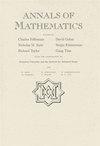广义肥皂泡和具有正标量曲率的流形拓扑学 | 数学年鉴
IF 5.7
1区 数学
Q1 MATHEMATICS
引用次数: 0
摘要
我们证明,对于$n\in \{4,5\}$,一个封闭的非球面$n$流形不包含一个具有正标量曲率的黎曼度量。此外,我们还证明,对于$n\leq 7$,$n$-torus与任意流形的连接和不包含一个具有正标量曲率的完整度量。这些结果中的一个关键几何工具是广义肥皂泡--对于规定均值曲率函数(也称为 $n\mu $-泡)是静止的曲面。本文章由计算机程序翻译,如有差异,请以英文原文为准。
Generalized soap bubbles and the topology of manifolds with positive scalar curvature | Annals of Mathematics
We prove that for $n\in \{4,5\}$, a closed aspherical $n$-manifold does not admit a Riemannian metric with positive scalar curvature.
Additionally, we show that for $n\leq 7$, the connected sum of a $n$-torus with an arbitrary manifold does not admit a complete metric of positive scalar curvature. When combined with contributions by Lesourd–Unger–Yau, this proves that the Schoen–Yau Liouville theorem holds for all locally conformally flat manifolds with non-negative scalar curvature.
A key geometric tool in these results are generalized soap bubbles—surfaces that are stationary for prescribed-mean-curvature functionals (also called $\mu $-bubbles).
求助全文
通过发布文献求助,成功后即可免费获取论文全文。
去求助
来源期刊

Annals of Mathematics
数学-数学
CiteScore
9.10
自引率
2.00%
发文量
29
审稿时长
12 months
期刊介绍:
The Annals of Mathematics is published bimonthly by the Department of Mathematics at Princeton University with the cooperation of the Institute for Advanced Study. Founded in 1884 by Ormond Stone of the University of Virginia, the journal was transferred in 1899 to Harvard University, and in 1911 to Princeton University. Since 1933, the Annals has been edited jointly by Princeton University and the Institute for Advanced Study.
 求助内容:
求助内容: 应助结果提醒方式:
应助结果提醒方式:


